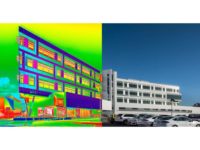Insulated Metal Panels Create Bus Terminal of the Future

In Jacksonville, Fla., it’s not just about the journey, but where it begins or ends. Jacksonville Transportation Authority has set out to create the city’s own unique version of Grand Central Station with a brand-new hub, set to open on March 30. The $57 million Jacksonville Regional Transportation Center (JTRC) focuses on the future that takes the needs of the city, the passengers and the environment into account.
In a master plan that united local and regional shuttles, bus lines, taxis and rideshares, the first phase involved the design of a brand-new, 9,660-square-foot Greyhound Bus Lines terminal, which opened in April 2018. It features 21 bus bays, customer drop-off, a ticket and customer service counter, indoor waiting area with plenty of power ports and restaurant.
Architect Pond & Company used a Greyhound prototype to guide the design of the terminal, while incorporating sustainable building materials. This included 29,000 square feet of Kingspan Optimo insulated metal panels in regal white and custom Greyhound blue and grey. Optimo is a single-component wall system that delivers a high-performance envelope. The panels are GREENGUARD Gold Certified, and when ordered with Kingspan’s QuadCore insulation, earn a Silver level Material Health Certificate and are Red List Free.
Kingspan’s Optimo panels increase energy efficiency by providing an R-value of 7.2 per inch ASTM C518 @ 75°F for standard PIR (8 per inch ASTM C518 @ 75°F for QuadCore). The panels have a flat exterior profile with stucco or non-embossed finishes available. Optimo panels can be oriented vertically or horizontally.
The advanced thermal efficiency plays a critical role in the terminal’s overall energy savings. The building has variable refrigerant flow HVAC units and a white roof to reflect the blazing hot Florida sun. LED lighting harvests daylight by dimming based on how much sunlight comes into the building.
When the second phase of the JTRC opens, the Greyhound terminal will be connected by a pedestrian bridge. With the introduction of the JTRC to Jacksonville’s downtown business district, the vision for an interconnected, sustainable future is now within reach for Florida’s largest city.
Looking for a reprint of this article?
From high-res PDFs to custom plaques, order your copy today!





